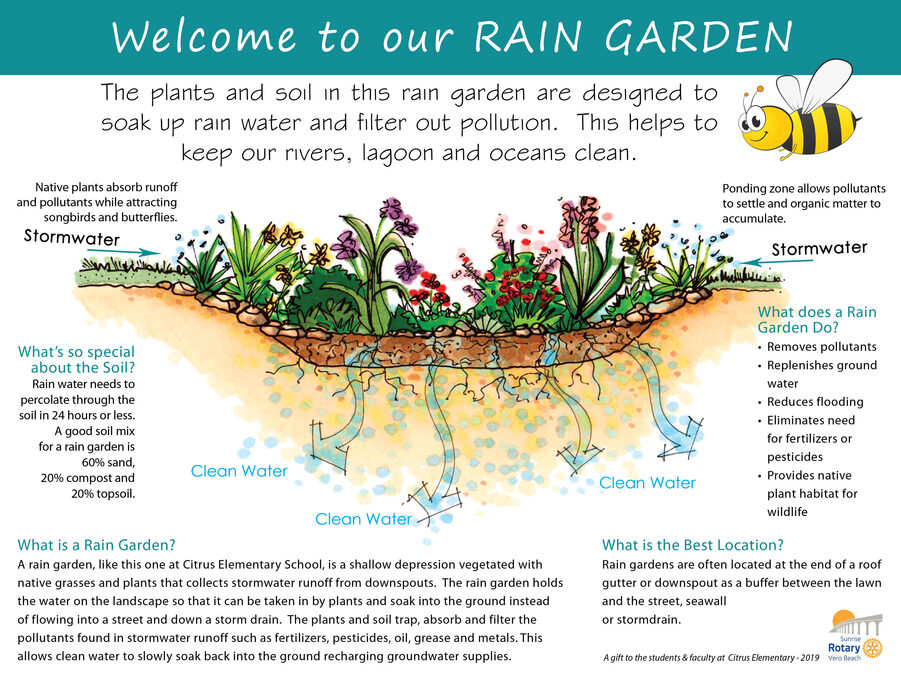HOW TO CONSTRUCT YOUR OWN RAIN GARDEN
If you missed our free rain garden workshops, it's not too late to learn. Take a look at the workshop presentation, and feel free to contact Sunrise Rotary if you still have questions.
Sunrise Rotary Vero Beach Rain Garden Workshop - How to Construct Your Own Rain Garden
Sunrise Rotary Offers Incentives for Residential Rain Gardens to help the indian river lagoon
Sunrise Rotary Vero Beach's Residential Rain Garden Incentive Program encourages property owners to install and maintain rain gardens on their property in an effort to decrease the amount of pollutants entering the Indian River Lagoon.
The incentive consists of a direct cash payment that may be used to offset any expenses related to the planning, planting and maintenance of the rain garden. Incentives are limited to properties located inside the City limits, and only one incentive is provided per property regardless of the number of rain gardens that may be located on that property. In order to be eligible for the incentive program, residential property owners are required to complete each of the following steps:
- Complete the Residential Rain Garden Program Application and submit it to Sunrise Rotary using the address and contact information shown on page two of the application (may also be submitted at a workshop).
- Attend one of the rain garden instructional workshops offered by Sunrise Rotary. Dates and locations for the workshops may be found on Sunrise Rotary’ rain garden website at SunriseRotaryVeroBeach.org. It is mandatory that you sign-in at the workshop in order to qualify for the incentive. Workshops are provided at no cost, but you must register in advance. See contact information below.
- At the workshop, you will receive free technical assistance to help you determine the optimal location on your property for a rain garden and help with selecting the appropriate plants for the chosen rain garden location. You will also receive advice on routing storm water to your rain garden as well as advice on rain garden maintenance.
- Sign a Homeowner Rain Garden Agreement and return it to Sunrise Rotary at the address shown on the Agreement form. The Agreement form is provided at the rain garden workshops. The Agreement form will ask you to indicate if you will be using one of the rain garden designs provided by Sunrise Rotary. If you are not using a standard design, you will need to provide a copy of the layout that you will be using (including a plant list) along with a completed and signed Agreement form (may also be submitted at a workshop).
- Register your rain garden by going to the Sunrise Rotary Rain Garden page at SunriseRotaryVeroBeach.org. It is important to register the rain garden on your property. If you do not have access to the internet, please request a Rain Garden Registration Form by calling Sunrise Rotary. You may register your rain garden by completing the registration form and mailing it to the address shown on the form. Up to three photographs (.jpg) will also be accepted for posting on the website.
- After registering your completed rain garden, a Sunrise Rotarian will schedule an appointment with you to inspect the garden for compliance with the standards addressed in the workshop. At the time of inspection, the owner will be presented with a certificate of completion.
- Sunrise Rotary will pay an incentive to owners of certified rain gardens at a rate of $2.00 per square foot of rain garden installed up to $250. The payment will not exceed $250. Property owners seeking the incentive must file a W-9 IRS form with Sunrise Rotary. The payment will be mailed to the property owner after all of the qualifying activities have been completed.
CONTACT FOR MORE INFORMATION
For more information on Sunrise Rotary Vero Beach’s Lagoon Rain Garden Incentive Program, contact:
Sunrise Rotary Vero Beach
Mike Murphy, Environmental Chair
murphymd@usa.net
Robin Pelensky, President
rpelensky@surlaterrela.com

Mike Murphy, Sunrise Rotary's Environmental Chair, installs interpretive signage at the new rain garden at Stormgrove Middle School.

HOW A RAIN GARDEN WORKS
A rain garden is a shallow depression in the landscape vegetated with native grasses and plants that collects stormwater runoff. The rain garden holds the stormwater so that it can be taken in by the plant roots, and allows the water to soak into the ground instead of flowing into a street or combined sewer. Together, the plants and soil trap, absorb and filter the pollutants found in stormwater runoff such as fertilizers, pesticides, oil, grease and metals. This process allows clean water to slowly soak back into the ground recharging groundwater supplies.
Frequently Asked Questions (FAQ) about Lagoon Rain Gardens
-Is a lagoon rain garden a pond? Lagoon gardens are not ponds. When properly designed, a lagoon garden should only hold water for about 24 hours.
-Will a lagoon rain garden be a breeding ground for mosquitoes? No! Properly designed lagoon rain gardens are, in fact, mosquito death traps because the water soaks into the ground within a day or so. The mosquito life cycle takes place in standing water and lasts seven to 12 days. Mosquitoes lay eggs in standing water. The eggs hatch into larva and then grow into flying insects. If a mosquito lays its eggs in a lagoon garden with standing water and the water soaks into the ground, the eggs won't have an opportunity to develop and will die.
-Are rain gardens hard to maintain? The benefit of using native plants in a lagoon rain garden is that they are well adapted to their natural surroundings and do not require a lot of maintenance, fertilizers or pesticides. The bulk of lagoon rain garden maintenance involves periodic watering and weeding.
-Will I need to water my lagoon rain garden? You will need to water the lagoon garden during the first one or two growing seasons until the plants become established. About an inch of water a week is a good rule of thumb. In later years, the garden will only need to be watered during prolonged dry periods.
-Are lagoon gardens expensive to build? Lagoon rain gardens do not have to be expensive. If you build the lagoon rain garden yourself, the main cost is typically the plants and mulch. An average lagoon garden will cost almost nothing if you do the work yourself and use plants from other parts of your landscaping or receive cuttings from friends or family. If you hire a landscaper to design and construct the garden and install the plants, the cost could be $12 to $20 per square foot.
-Where is the best location for a lagoon rain garden? Lagoon rain gardens should be located at least 10 feet from the house foundation. A lagoon rain garden can be used to direct water away from the house by routing downspouts toward the garden. When planted along a seawall, the garden is a good way to capture and absorb excess nutrients that run off a lawn during a rain storm.
REGISTER YOUR ROTARY RAIN GARDEN
Registration information to be made available soon.
